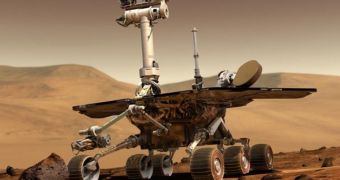As we were telling you earlier today, the Mars Exploration Rover (MER) component Spirit has been immobilized on the surface of the Red Planet, following a series of misfortunes. The exploration robot thus comes at the end of a journey that lasted several tens of times longer than it was originally planned. Since landing in 2004, it has trekked at the bottom of the Gusev crater, and has produced science like no other rover before it. Although it drove significantly less than its twin Opportunity, the amount of data it collected was just as massive and important.
Spirit's final location has now been confirmed as Troy, the patch of loose soil it broke into in May, 2009. The sand was covered by a thin crust of harder material, which collapsed under the robot's weight, and made the wheels sink into the stuff up to their hubcaps. Now, this place will become the rover's home for the duration of its mission. Coordinates for Troy are 14.6 degrees South, 175.5 degrees East, Space Fellowship reports. Still, despite the gloom that is already being expressed on the Internet of this event, experts managing Spirit from the NASA Jet Propulsion Laboratory (JPL) say that the machine still has life in it, and that it will continue to perform stationary science from Troy.
Some of the most amazing technological achievements that Spirit's long life marked included driving more than 4.8 miles (7,730 meters) through the bottom of the Gusev Crater. Since 2006, it has been driving backwards, as one of its front wheels stopped working at that time. Additionally, it climbed more than 82 meters in height on the Husband Hill, the tallest geological feature in its area. It was able to scale a 30-degree steep on Columbia Hills, all while beaming back in excess of 27,000 raw images of Mars, and 16 color panoramas. Its instruments were also able to drill into 15 selected rocks, and to brush over 92 others as well.
But undoubtedly one of its greatest achievements was being able to withstand three Martian winters, and now preparing to brave the fourth. In spite of almost no light, and temperatures that would drive chills through your bones, the machine endured, attesting to the skill and dedication of the engineers that built it, and to the dedication of the experts that carefully positioned it in the correct angle to make the most of what little sunlight was available at its location. At the same time, Spirit is also able to perform a number of automated tasks, such as target tracking, hazard navigation and cloud recognition.
“Spirit has been a wonderful workhorse. Because of Spirit’s visit to the Columbia Hills, we know it was a violent place, a place churned by impacts and volcanic explosions. Spirit has shown us an ancient Mars that was very different from the Mars we see today,” Cornell University MER principal investigator Steve Squyres says of the wonderful machine. One could argue that, indeed, the robot was aptly named for all the hardships it endured and prevailed upon.
Awards Spirit has fully earned over the years:
2004 Best of the Best – Software of the Year Award from NASA; 2004 Best of What’s New Grand Award from Popular Science; 2005 Laureates Hall of Fame Award from Aviation Week and Space Technology; 2007 Best Corporate/Team Achievement Award at the Sir Arthur Clarke Awards in England; 2009 Thomas O. Paine Award for the Advancement of Human Exploration of Mars from the Planetary Society.

 14 DAY TRIAL //
14 DAY TRIAL //